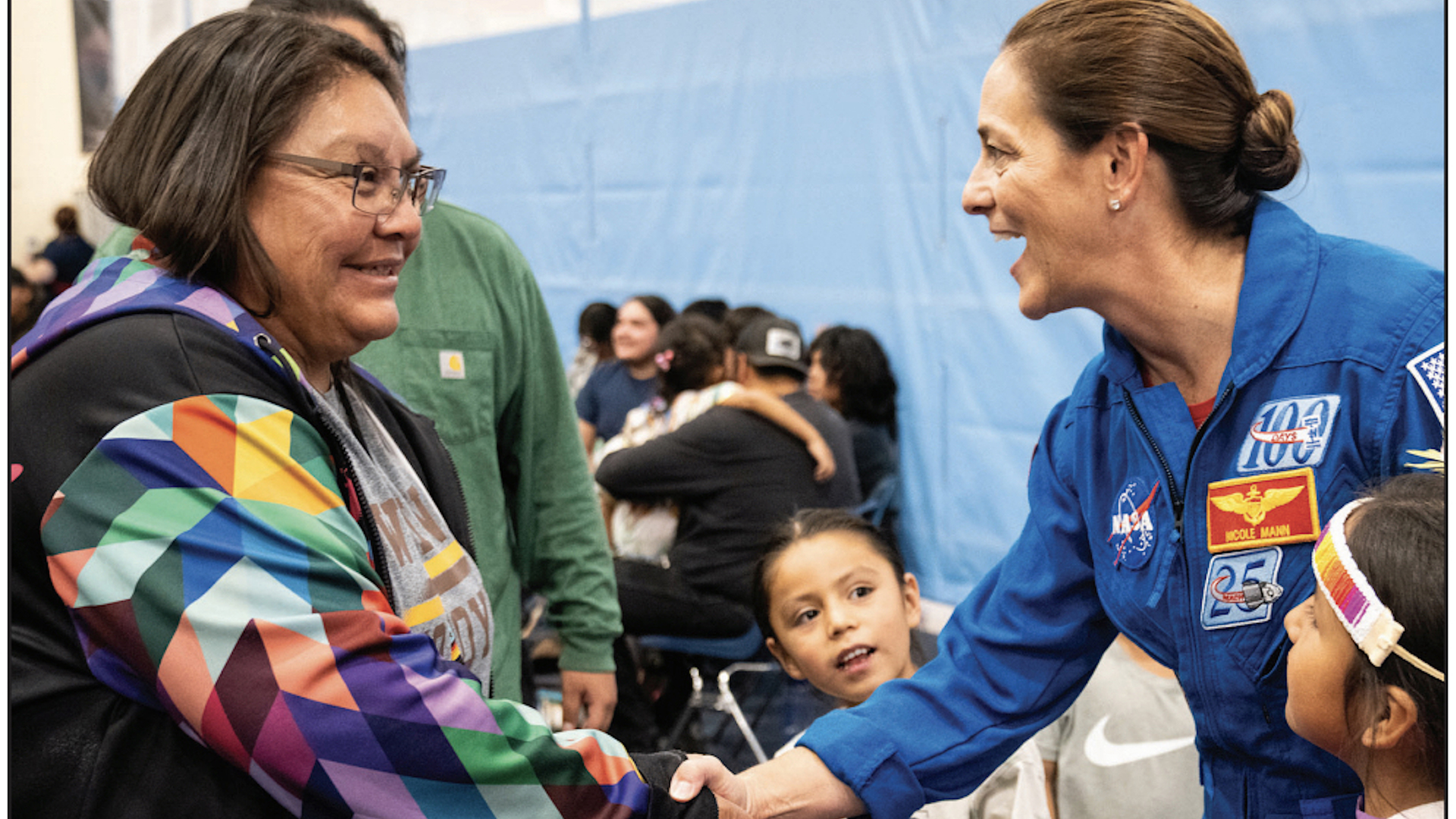From Ethete to the stars

By Marit Gookin
Lander Journal
Via Wyoming News Exchange
LANDER — Forget Mount Everest. On Tuesday afternoon, the closest you could get to space from Earth was in Ethete.
“Have you ever wondered what it felt like to float in space?” Chloe Iron Cloud asked the students assembled in Wyoming Indian High School’s gymnasium.
All of the high school and middle school students at Wyoming Indian were in the stands; when the woman with the answer to Iron Cloud’s question walked into the room, she was greeted with thunderous applause.
Colonel Nicole Aunapu Mann, U.S. Marine Corps colonel and NASA astronaut, is the first female Native American astronaut.
“When I was a young girl growing up, I have to be honest, I had no idea I would ever be an astronaut,” she told the students in the high school gym. “It seemed like something other people did.”
For the last six years, WIHS has been participating in NASA’s HUNCH (High school students United with NASA to Create Hardware) program, which works with participating high schools to make items for astronauts to use in space.
The items have to go through a review process, but if they get certified – like WIHS’ hygiene kits have been – they make their way toward an astronaut’s hands, either on the International Space Station or elsewhere.
Wyoming Indian is the only majority-Native American school in the entire country to participate in the program, and one of just three schools in Wyoming.
Earlier this year, the students’ work earned them recognition from NASA; representative Flo Gold handed out certificates and brought a locker, eventually bound for the ISS, that the students, teachers, and families were all given an opportunity to sign.
Earlier this week, Gold was back – and this time, she didn’t come alone.
Mann, a member of the Wailacki of the Round Valley Indian Tribes in California, grew up loving engineering and soccer, she explained, and she knew she wanted to serve her country. That path took her to the Naval Academy; the summer of her senior year, she got to go up in a fighter jet, and knew immediately that it was what she wanted to do next.
After earning a master’s degree in engineering from Stanford University, she flew combat missions in Iraq and Afghanistan before setting her sights on test pilot school.
She was selected for astronaut candidate training in 2013.
On October 5, 2022, she launched for the ISS as commander of Crew-5.
“It wasn’t easy,” she told the high school and middle school students. “But it was so worth it … You have to reach out, and you have to work hard to find those opportunities.”
Mann spent 157 days on the ISS, with an international crew.
“Our primary mission is science,” she explained, but having downtime is important for the astronauts, too – and some of that downtime includes sharing cultural traditions with each other.
She showed the students images of the crew in Santa hats and playing single-player baseball.
One of the astronauts’ favorite places to go, she added, is the cupola, which allows them to look down at Earth and out across the stars.
“It’s hard to explain how incredibly beautiful and alive [Earth] is,” she remarked.
Each astronaut is allowed to bring a personal item from home; Mann’s, which she kept attached to the wall in her sleeping quarters, was a dreamcatcher.
“It would float and fly in my room,” she described, and constantly reminded her of where she came from “and all the people in my community who helped me discover my dreams.”
Attending a similar assembly at the elementary school later that day, Mann encouraged the students to dream big. Becoming an astronaut – or an engineer, or a pilot, or whatever their dream is – is hard work, she told them, but it’s not beyond the reach of students in Ethete, Wyo.
Wyoming Indian Elementary’s students, she noted, were just about the right age to potentially be able to be on a NASA mission to Mars someday.
At the elementary school, Mann was given a blanket and was the first person to be inducted into the Wyoming Indian Indigenous Hall of Fame.
Before heading to the elementary school, Mann was peppered with questions from the high school and middle school students.
Some were serious, asking about things she was scared of and whether she got homesick, while other students took the opportunity to ask whether the Earth is flat and if she saw any aliens.
In response to one student who asked the all-important question about whether the moon is made of cheese, Mann said that she didn’t think so, but she hadn’t been to the moon herself.
“If I get a chance to walk on the moon, I’ll come back and let you know,” she said.
This story was published on September 14, 2024.








